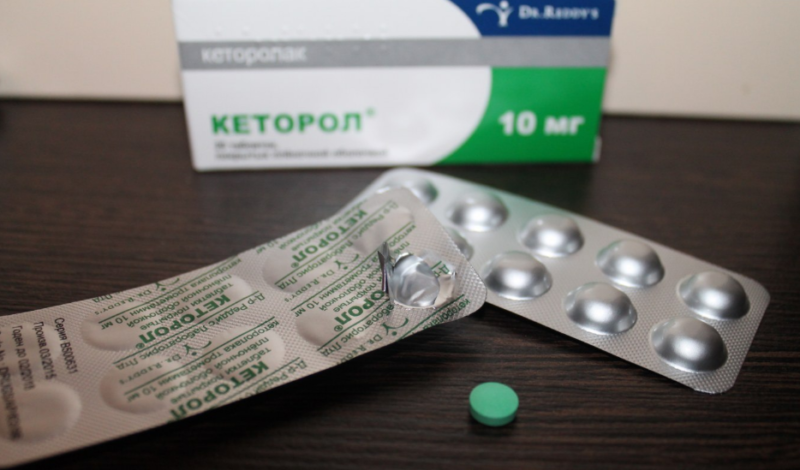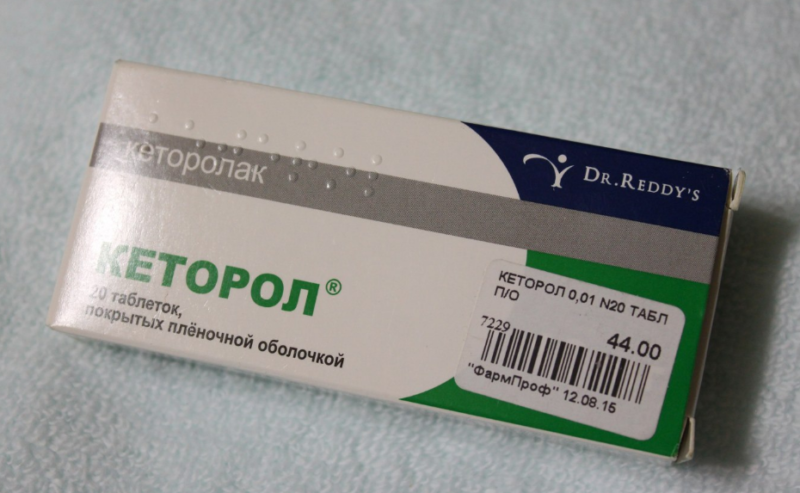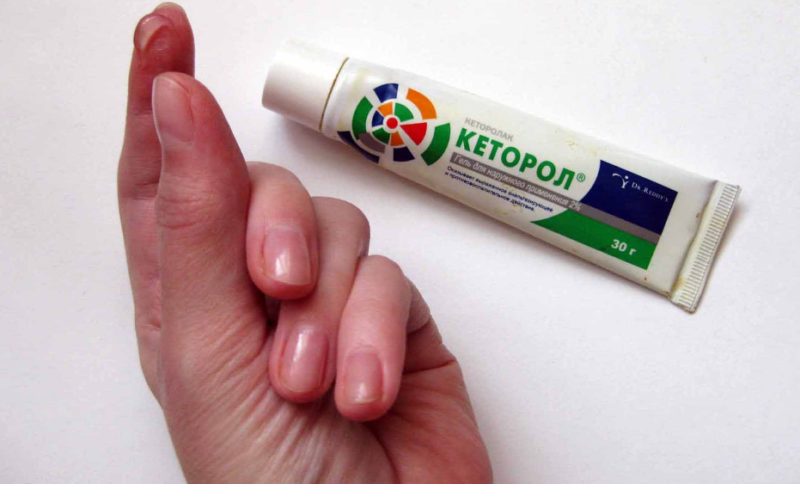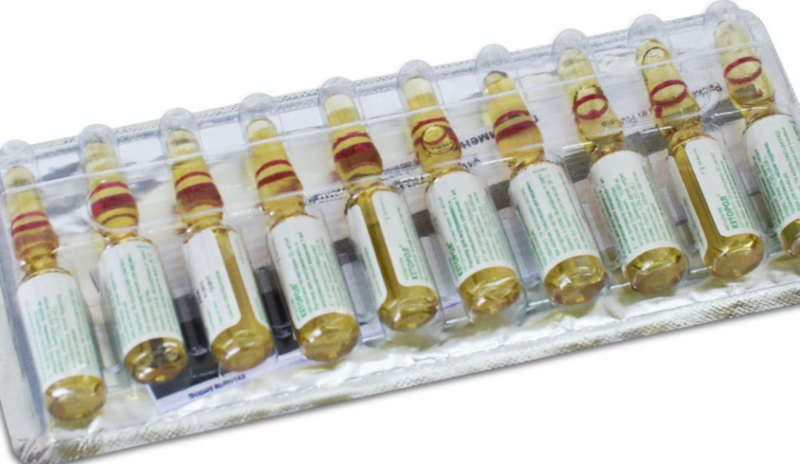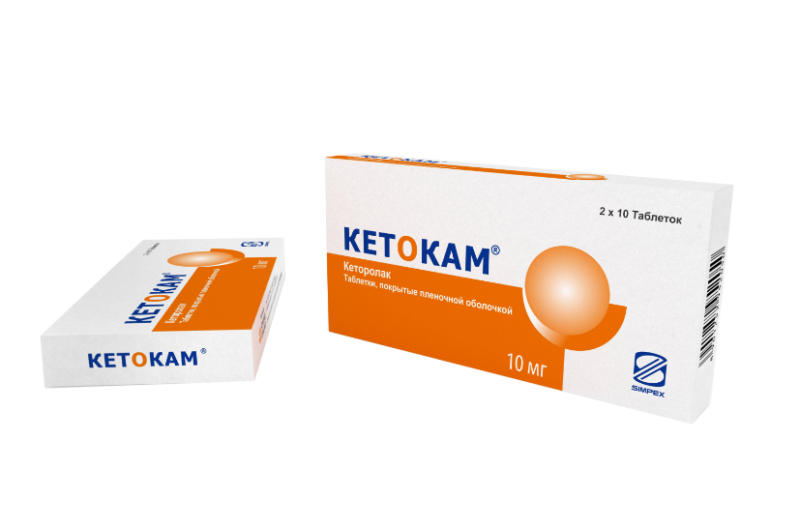Ketorol is a highly active non-narcotic analgesic pharmaceutical with a moderate anti-inflammatory effect and an additional antipyretic effect. What helps Ketorol in different dosage forms, and for which diseases it is prescribed, is described in detail in the medical instructions. The medicine is included in the list of essential medicines that are vital in many pathological conditions.
Material Content:
- 1 Description of release forms and composition of the drug
- 2 Pharmacological properties and pharmacokinetics
- 3 What helps Ketorol
- 4 Instructions for use and dosage
- 5 During pregnancy and lactation
- 6 Drug interaction
- 7 Ketorol Compatibility with Alcohol
- 8 Contraindications, side effects and overdose
- 9 Analogs
Description of release forms and composition of the drug
The active treatment substance in the drug is ketorolac (in the form of trometamine or trometamol).
The drug with the name "Ketorol" is available in 3 pharmacological forms:
- Convex round tablets in a green enteric coating embossed in the form of the letter S on one side, packed in a paper bag of 20 units. One tablet contains 10 mg of the active ingredient.
- Transparent flavored gel for external use in an aluminum tube of 30 g. 1 mg of gel contains 20 mg of therapeutic substance.
- A clear, colorless or pale straw-colored medicinal solution prescribed for administration to the muscle and vein. Poured into ampoules of 1 ml of brown glass of 10 units in a contour transparent blister. 1 ml of the solution includes 30 mg of the treating component.
The composition of each dosage form includes additional pharmacological substances necessary for preservation, morphogenesis and emulsification.
The choice of dosage form is determined by the strength of the pain and the condition of the patient.
Pharmacological properties and pharmacokinetics
Non-narcotic analgesic is used for the short-term suppression of moderate and severe pain, inflammation. Doctors rarely recommend Ketorol for fever, as its action against fever is rather weak, and there are other medications that can do this task more quickly.
The pronounced analgesic effect of the drug is associated with the inhibition of the work of special enzymes - cyclooxygenases of the first and second types (COX-1 and 2) and a decrease in the irritation of pain receptors. Ketorolac inhibits the production of hormone-like substances of prostaglandins, which play the role of regulators of pain, inflammation factors and changes in tissue temperature.
The intensity of the analgesic effect of the drug far exceeds the capabilities of other analgesics and NSAIDs (Paracetamol, Analgin, No-shpa) and is comparable to the activity of opiates, including morphine.
So, after injecting 30 mg of ketorolac into the muscle, the degree of pain relief will be similar to using 12 mg of morphine. At the same time, Ketorol has certain advantages compared to narcotic drugs.
When using the recommended doses:
- does not cause drug dependence, since it does not affect opioid receptors;
- does not have a tranquilizing or sleeping pill;
- does not worsen the respiratory process (unlike opioid painkillers);
- does not cause urinary retention;
- It does not directly affect the functioning of the heart and vascular system, does not change the pulse rate and blood pressure.
These properties of the drug cause a smaller list of contraindications, undesirable side reactions and a wider range of applications.
When ingested in any dosage form, it is actively absorbed and distributed. More than half of the dose of medication received in the body is processed in the liver, more than 90% is removed in the urine, and only a small part through the intestines.
The half-life of ketorolac during normal kidney function ranges from 3 to 9 hours, which depends on the dosage form, dosage, and age of the patient (in weakened and elderly people, it increases due to inhibited functioning of the kidneys). With renal dysfunction, blood purification from drugs slows down, and the half-life can increase to 12.5 hours or more.
What helps Ketorol
"Ketorol" is primarily necessary for a pain attack that is accompanied (or not accompanied) by fever and inflammatory phenomena.
Although the medicine is referred to as non-hormonal anti-inflammatory drugs (NSAIDs), its main purpose is precisely the pronounced suppression of intense pain.
The pharmaceutical product is designed to eliminate symptoms, acts short-term and does not affect the cause and progression of the underlying pathology.
The main indications for the use of Ketorol are pain sensations of medium and high intensity in the following pathological conditions:
- renal colic;
- severe toothache and headache, including migraines;
- dislocations, fractures, damage to the ligamentous apparatus of the joint, soft tissue bruises;
- inflammation of the tissues in the region of the periarticular sac, tendon, synovial membrane of the joint;
- arthropathies, including the psoriatic form of arthritis;
- degenerative dystrophic diseases of the spine, ankylosing spondylitis;
- rheumatic diseases;
- neuralgia and neuritis;
- radiculopathy, gout;
- esophageal spasm, pylorospasm;
- skeletal muscle inflammation (myositis), muscle pain of a different nature;
- malignant processes (including foci of metastases in bone tissue).
In addition, the medication is used today for pain disorders against the background of a severely occurring narcotic withdrawal syndrome.
Ketorolac is actively used for pain relief in surgical dentistry, in the postpartum and postoperative period after intraperitoneal, gynecological, orthopedic surgeries.
Instructions for use and dosage
Before prescribing a medication, it is important to establish whether the patient has previously had episodes of allergy to any analgesics and NSAIDs. The patient's condition after taking the first dose is carefully monitored.
Pills and injections
In injections, "Ketorol" is allowed to be used for pain relief with daily use no longer than 5 days, in tablets - 7 days.
The dosages recommended in the instructions are reduced as much as possible, given the strength of the pain. To minimize adverse reactions, it is advisable to reduce the amount of ketorolac to a dose at which pain relief is noted. Optimally, if the medicine is taken episodically or in a short course.
- Ketorol tablets. Patients from 16 years old can take a 10 mg tablet once or up to 4 times in 24 hours, which is determined by the degree and duration of the pain attack. The greatest amount in 24 hours is 40 mg. Excessively fatty foods delay the onset of the therapeutic effect for 60 minutes, reducing the content of the drug in the blood.
- Ketorol injections. Adults from 16 years of age or weighing more than 50 kg are usually given 1 ampoule (30 mg) after 6 to 8 hours, but the total amount of ketorolac cannot be more than 90 mg per day (taking the medicine in tablets). At a time, it is allowed to inject into the muscle or intravenously no more than 60 mg of the therapeutic substance (2 ampoules).
- For patients with chronic kidney disease, people over 65 years old or weighing less than 50 kg, a single dose is limited to half an ampoule (15 mg), maximum 30 mg. For 24 hours, the total amount of Ketorol administered to the patient cannot be more than 60 mg (2 ampoules). An intramuscular injection is done for 4 to 5 seconds, intravenous infusion is performed for 15 to 17 seconds.
The time of onset of the maximum effect depends on the dose, weight of the patient, the strength of the painful manifestations. A noticeable weakening of pain after ingestion is fixed after 45 - 80 minutes, after injection into the muscle - after 15 - 30 minutes, into a vein - from 30 seconds to 5 minutes.
Despite the fact that officially Ketorolac is not allowed to be prescribed in childhood and adolescence, it is often used to alleviate severe pain after surgery or injuries due to the lack of alternative drugs (other than drugs) with an equally strong effect.
Gel
Ketorol gel 2% is used as an external remedy for pain against the background of inflammation and damage to muscles and joints. It is uniformly and thinly applied to the focus of maximum pain up to 4 times a day in a volume of 1 - 2 ml (gel column 1 - 2 cm long). The skin should be clean and dry. In the area of gel treatment, there should be no eczema, ulcers, wounds, ulcers, blisters and other injuries. The gel applied to the skin is not allowed to be covered with a medical plaster, an airtight dressing. The duration of the course of local applications is limited to 10 days.
special instructions
Ketorol, like most NSAIDs, increases irritability and the risk of damage to the gastric mucosa. To prevent this condition, during treatment, parallel administration of funds with omeprazole or esomeprazole that protect the gastrointestinal mucosa (Omez, Ultop, Losek, Orthanol) is required.
In patients with blood diseases, gastrointestinal ulcers, and in patients after and before surgery, the pharmaceutical product is used to constantly monitor blood counts and coagulograms, since ketorolac, although to a non-hazardous degree, nevertheless extends the time until the bleeding stops.
In case of unbearable pain, simultaneous administration of narcotic painkillers in reduced doses is allowed.
When drowsiness, weakness, dizziness occurs, activity and work that require precise manipulation and reaction speed (workers of hot shops, surgeons, industrial climbers, pilots, air traffic controllers, employees of the Ministry of Emergency Situations, and transport drivers) should be avoided.
During pregnancy and lactation
In significant quantities, the active component of the drug passes into breast milk, and about a tenth of the dose received passes into the fetal bloodstream through the placenta. In connection with this fact, Ketorol is forbidden to prescribe in any form to nursing mothers and patients bearing a child in order to prevent violations of the development of the fetus and baby.
The same prohibition applies to women in childbirth - the medicine is not used to anesthetize childbirth, but is used exclusively in the postpartum period, and the child must be transferred to artificial nutrition.
Drug interaction
It is necessary to take into account the likelihood of incompatibility or the occurrence of negative effects with the joint appointment of "Ketorol" with other pharmacological products.
| Medications in combination with ketorolac | Probable reactions |
|---|---|
| non-hormonal anti-inflammatory drugs, medications with aspirin, calcium, glucocorticosteroids, ethanol, Corticotropin | digestive tract ulceration, bleeding |
| other NSAIDs, including Xefocam, Indomethacin, Diclofenac, Ibuprofen, Meloxicam, Celecoxib | fluid retention, deterioration in cardiac activity, increased pressure |
| Paracetamol, Cyclosporin, ACE inhibitors (Captopril, Kapoten, Enalapril, Fosinopril, Fozinap, Fozicard) | kidney damage (nephrotoxicity) |
| Methotrexate | kidney and liver damage |
| medications with lithium, gold | toxicity increase |
| "Probenecid" | risk of increased side effects |
| anticoagulants (Sinkumar, Warfarex, Fenilin), Heparin, Froxiparin, thrombolytics (Streptokinase, Lanoteplaza), antiplatelet agents (Clopidex, Trental, Clopidogrel, Curanti "," Eptifibatide "), cephalosporins antibiotics, valproic acid | risk of hemorrhage, bleeding |
| antihypertensive drugs and diuretics ("Furosemide", "Lasix", "Trigrim") | reduction of therapeutic effect |
| narcotic analgesics | doses of opiates can be significantly reduced while maintaining pronounced analgesia |
| Insulin, a blood sugar lowering medication | the risk of a sharp drop in glucose and the development of hypoglycemic coma (dose recalculation is necessary) |
Before using Ketorol, you need to discuss with your doctor the possibility of combining it with other medicines that the patient is taking.
Ketorol Compatibility with Alcohol
Taking a pharmaceutical with alcohol is extremely dangerous. Severe liver poisoning is possible, as well as an additional increase in the action of ethanol on the nervous system with the development of convulsions, hallucinations, a depressive state, overexcitation, and psychosis.
Contraindications, side effects and overdose
A non-narcotic analgesic is a pharmacological product with a powerful effect and, at the same time, with a serious list of contraindications and additional manifestations that negatively affect the body.
It is forbidden to prescribe an analgesic drug if conditions such as:
- intolerance to ketorolac and any components of the medication, other NSAIDs;
- allergic reactions that apply to any body system;
- acute period of ulcerative colitis, gastrointestinal ulcer, Crohn's disease;
- any bleeding, hemorrhage, including hemorrhagic stroke;
- heart attack
- hemophilia, hemorrhages of any type, blood coagulation disorders;
- severe insufficiency of myocardial functioning, condition after heart surgery;
- marked weakening of kidney function (creatinine Cl less than 30 ml / min), progressive kidney disease,
- severe liver damage;
- full or partial combination of multiple polyps in the nasal cavity and sinus sinuses, asthma, intolerance to any non-steroidal anti-inflammatory drugs;
- dehydration, decreased circulating blood volume;
- confirmed hypercalcemia or hyperkalemia;
- weeping with dermatoses, foci of eczema, suppuration, damage to the skin (for gel);
In addition, the use of Ketorol is not allowed:
- before prolonged or extensive surgery with a high risk of bleeding (48 hours before and after surgery);
- for preventive pain relief, maintaining anesthesia during operations,
- for labor pain relief.
The conditions when the pharmaceutical product should be used with caution include:
- age up to 12 years for a gel, up to 16 and after 65 years - for other dosage forms;
- moderate course of all the above pathologies, during exacerbation of which the drug is prohibited;
- coronary disease, damage to the vessels of the brain, heart;
- arterial hypertension;
- diabetes;
- systemic lupus erythematosus.
Some sources about the pharmaceutical drug prescribed to limit the dose and duration of Ketorol if the patient receives glucocorticoids (Dexamethasone, Prednisolone), SSRI antidepressants (Sertralin, Citalopram, Paroxetine).
Unwanted effects
Adverse reactions and complications, as a rule, are observed with long-term use or in excess of doses, especially more than 90 mg per day.
Most often noted: pain in the stomach, loose stools, headache, drowsiness. Less commonly, patients complain of constipation, heaviness in the stomach, increased pressure, skin rash and itching, stomatitis, heartburn, nasal congestion.
Complications such as:
- bronchospasm, laryngeal edema with shortness of breath;
- vomiting, ulcerative lesions of the digestive organs, bleeding in the stomach and intestines, blackening of feces and vomit, jaundice, hepatitis, acute pancreatitis;
- lower back pain, urinary retention, acute renal failure, protein in the urine, anemia, purpura, nephritis, swelling of the face, legs, weight gain;
- visual and auditory disorders;
- various types of bleeding, including rectal, nasal, postoperative;
- exfoliative dermatitis with fever, swelling of the tonsils;
- urticaria, acute allergy with shortness of breath, swelling of the larynx, tongue, eyelids;
- Lyell or Stevens-Johnson syndrome.
When gel is applied to large areas of the skin or when the gel is applied under an airtight dressing, there is a high risk of ketorolac affecting the entire body with the development of characteristic side effects.
If any adverse reactions occur, the use of the drug is stopped. With the development of acute, life-threatening conditions, they immediately call an ambulance.
Overdose
An overdose is characterized by the appearance or intensification of adverse reactions that have already manifested, including the development of hemorrhages, acute renal failure, meningitis with seizures, pulmonary edema.
In mild cases, washing the stomach, taking Polysorb as an active adsorbent is enough. In severe conditions, immediate hospitalization is required for detoxification procedures in the hospital and preservation of body functions. Hemodialysis will not help with an overdose due to the almost 100% connection of ketorolac with plasma proteins.
Analogs
Pharmaceutical products with the same healing substance in the composition: “Ketokam”, “Dolak”, “Ketanov”, eye drops “Akyular”. It should be noted that the Ketorol analogues in the form of eye drops effectively relieve pain in corneal abrasions, after cataract excision, eliminate itching in the eyes, relieve inflammation, and are used in the process of eye surgery.
Other strong painkillers with a similar effect: Ketonal (ketoprofen), which many experts consider an even more powerful pain medication, Dexonal, Flamadex, Dexalgin.


